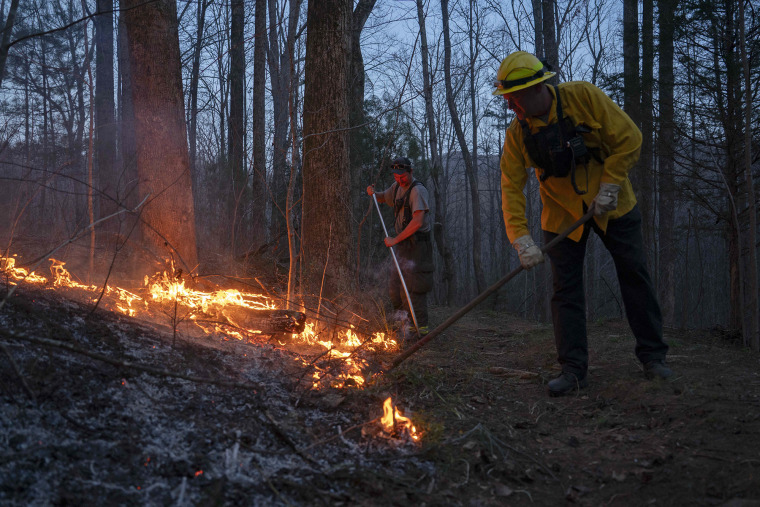Evacuation orders and recommendations were in place for parts of the western foothills of the Carolinas, where nearly a half-dozen wildfires were feeding on dry woodlands, officials said Sunday.
The fight against a trio of fires in Polk County, North Carolina, was taken over by a federal incident management team bolstered by out-of-state help, including 25 firefighters from Oregon who arrived by plane on Saturday, officials said at a community meeting Sunday.
No injuries or deaths have been reported.
Gov. Josh Stein said the Federal Emergency Management Agency approved a grant to help the state respond to the blazes. Polk County government declared a state of emergency on Wednesday, when the more than 2,000-acre Black Cove Fire started in Green River Gorge.
On Sunday, the North Carolina Department of Agriculture and Consumer Services said the blaze was 0% contained. New evacuations were ordered for residents of five roadways in the area, according to Polk County Emergency Management.

Since Friday, residents of more than a dozen streets and roadways in the area of the Black Cove Fire were ordered to evacuate, with some of those residents allowed to return.
Despite the new evacuations, receptive fuels and stubborn heat in fire-charred earth doused by water-dropping aircraft over the weekend, firefighters expressed some confidence that progress was being made on the fire.
"We’re holding that fire in that creek drainage," Brian Rogers, a state forest ranger who’s a manager for the federal response, said as he pointed at a fire map during a community meeting Sunday. "We haven’t had any movement on it."
The Deep Woods Fire nearby has burned more than 2,500 acres and also stood at 0% containment, the department said in a statement. Residents of two roadways were ordered to evacuate as firefighters worked on structure protection on the southern flank of the blaze, the North Carolina Department of Agriculture and Consumer Services said.
Rogers said firefighters were letting blaze burn itself out in places as it ran out of ground at logging roads connected by new fire lines on Sunday.
The third in a trio of fires that compose the state's Black Cove Complex Fires is the 199-acre Fish Hook Fire, officially 50% contained but pushed back enough that evacuation orders were lifted, the department said.
"We’re feeling really confident of where we’re at on Fish Hook," Rogers said.
Another blaze was spotted by a firefighter moving between hot zones in western North Carolina over the weekend, he said, but it wasn't clear if that was a fourth fire or one of the existing wildfires.
North Carolina is in its annual spring wildfire season, and the state Forest Service on Friday imposed a statewide burn ban.
“Our top priority is always to protect lives, property and forestland across the state,” state Agriculture Commissioner Steve Troxler said in a statement. “It is imperative that folks adhere to this burn ban until further notice.”
In South Carolina, where there was also a burn ban, a fire is burning on top of Table Rock Mountain in Table Rock State Park, officials said.
South Carolina Gov. Henry McMaster on Saturday declared a state of emergency due to the fire, which is in Pickens County in the northwestern part of the state. A declaration of emergency allows state resources and other aid to be used.
The Table Rock Fire grew to 1,300 acres by Sunday evening, with 0% containment reported, the state Forestry Commission said, but firefighters made progress by extending fire breaks and sparking a prescribed burn to consume fuel between the wildfire and some homes.
"The burnout, which remains in progress, is being deemed successful," it said in a Sunday evening statement.
Another wildfire, the Persimmon Ridge Fire, grew from an estimated 50 acres Sunday afternoon to roughly 800, the fire commission said. It was expanding on state property in the Mountain Bridge Wilderness Area, where there was also 0% containment, according to the commission.
Officials on Sunday combined the two fires on paper, which sometimes precedes a takeover by a federally funded cooperative of state and local firefighters called a Complex Incident Management Team. The combined fires were being calling the Table Rock Complex Fire. A little more than 10 miles separated the individual blazes.
Western North Carolina and South Carolina were damaged by Hurricane Helene in September, and that was affecting the fire growth, the commission said.
"Spot fires continue to spark new ignitions outside of the original fire area," the South Carolina Forestry Commission said. "Exacerbating the situation is an abundance of downed timber from Hurricane Helene, which has increased the fuel load on the mountain."
At the beginning of the month, South Carolina was struck my more than 100 wildfires as firefighters in North Carolina battled blazes at all four of the state's national forests.
Over the weekend, the foothills east of the Blue Ridge Mountains were under the influence of a weak high pressure system that boosted high temperatures into the 70s, pushed out gusts as strong as 28 mph and inspired red flag warnings that alerted some communities of extreme fire danger, according to the National Weather Service office in Greer, South Carolina, which covers the western end of the Carolinas.
Relative humidity was about 20% on Sunday, it said, with the region covered by a "fire danger statement" that warns of elevated wildfire risk.
Rain was possible Monday as a low pressure system moves through the region, federal forecasters said, but fire weather could return during the work week.
"The combination of low relative humidity and drier fuels will increase fire danger Tuesday through Saturday," the weather service said in a hazardous weather outlook on Sunday.
Almost all of North and South Carolina has been classified as either “abnormally dry” or under moderate drought by the U.S. Drought Monitor, which is a collaboration of government agencies that include the U.S. Department of Agriculture and the National Oceanic and Atmospheric Administration.

